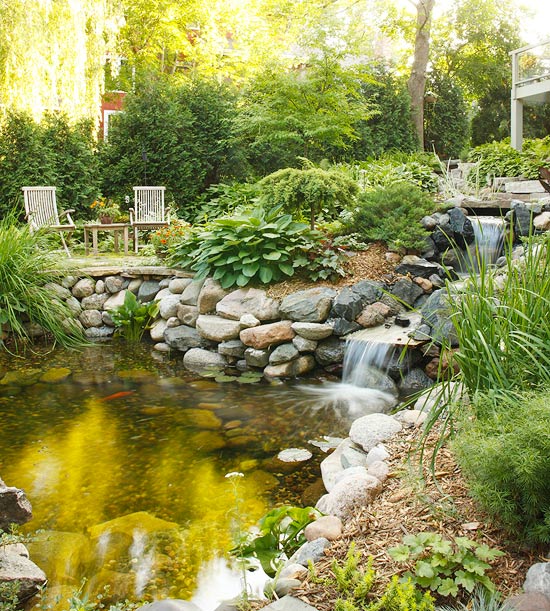
A great garden doesn't have to jack up your water bill. Here's how to keep watering costs down.
When you water your garden lavishly, your checking account isn't the only thing going down the drain. Increasingly, landscapes are putting a burden on community water supplies, especially in the West. Even in the South and the East Coast, water rationing is becoming increasingly common. But scrimping on water doesn't have to mean scrimping on your landscaping. It's all a matter of making a little water go a long way.
continue reading below
Design and Refine with Water Use in Mind
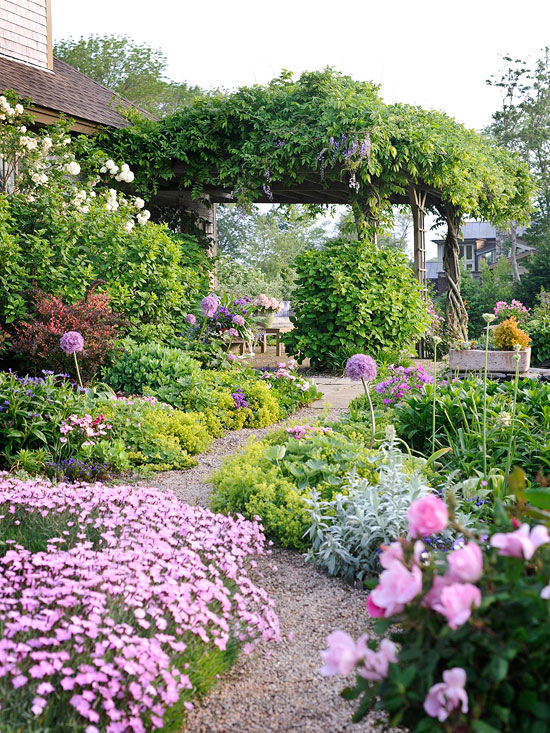
- Group plants according to water need. Highly drought-tolerant plants can go in one spot; moderate-water plants in another. High-water use plants go in another -- preferably close to the house so they're easier to get to with a hose.
- Go lightly on the annuals, heavier on perennials, and still heavier on shrubs. The larger the root system, usually, the less dependent the plant is on your babying it with the hose.
- Minimize lawn. Just as an SUV is a gas guzzler, turf is a water guzzler, requiring at least an inch of water every week. Use it as an accessory in your garden, something to set off beds and borders filled with low-maintenance small trees and shrubs and perennials -- not as the focal point. Bonus: You'll cut mowing and fall leaf raking time considerably.
- Mulch lavishly. Make sure annuals, perennials, trees, and shrubs all have 1 to 3 inches of a mulch such as wood chips or pine needles. It keeps the soil cooler and conserves moisture.
- Know your soil and plant accordingly. In the most of the Midwest, East Coast, and much of the South, improving soil with ample amounts of compost is the best way to go. Compost loosens clay soils and makes sandy soils more fertile and moist. Spread 6 inches of compost onto the top of the soil before digging a new bed. Otherwise, apply 1 to 2 inches of compost to the top of the soil in beds, borders, and vegetable gardens every year. It's the best investment you can make. In the West, however, "improve" soil with caution. Many drought-tolerant plants actually thrive in poor, lean, rocky soils and making the soil too rich or moisture-retentive can create disease and pest problems. They might even just plain rot.
Water Wisely
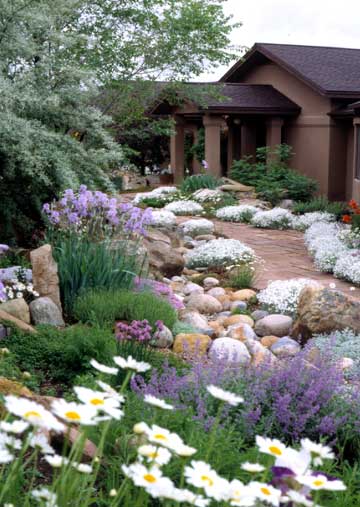
Gardens in the eastern two-thirds of the country need about an inch of water a week. Gardens in the West may need that much, though a well-planted garden can get by on a half inch or so a week. Really water-savvy gardens need no additional water, other than some extra water for first-year plants. Invest in a rain gauge so you never water too much or too little.
When watering the garden with a sprinkler, set out a pan in the sprinkler's path. When the pan has collected one inch of water, you know you've applied that much.
Water in the early morning -- preferably right before sunrise. Evaporation will be minimal but plant leaves will have time to dry quickly and thoroughly before fungal diseases set in. If getting up at 5 a.m. to water the garden sounds a wee bit daunting, invest in a good timer to attach to the hydrant so it will start the sprinkler automatically.
Avoid watering leaves. Yes, a plant benefits from an occasional shower to rinse off dust and insects, but generally, plants far prefer the water be delivered right at the roots. Watering the leaves encourages fungal diseases.
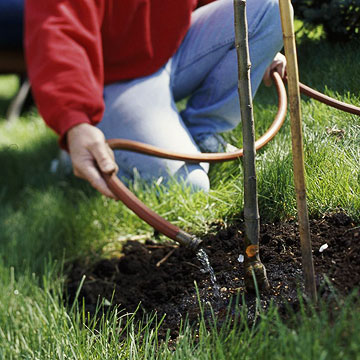
Water deeply and well rather than shallow and often. Giving plants -- whether they're lawns or perennials or shrubs -- little sips of water now and then does little good. It encourages shallow root development and the soil dries out again more quickly than if you had given it one good deep soak. After a good watering, water should work its way down at least several inches into the soil. Check by taking a trowel and digging down a bit to see if the water has penetrated well. In heavy clay soils, that might mean giving a plant a good soak until the water starts to puddle, then letting it sink in for a couple of hours and watering a second or even third time.
Invest in watering tools that make your job simpler. The easier it is, the more likely you are to do it when needed. Check out soaker hoses, microsprinklers, drip emitters, and bubblers. Each has its place in the landscape and each delivers water right to where the plant needs it -- the roots.
Check out water-conserving crystals. These look like rock salt but swell up to many times their original size and then resemble little blobs of clear Jell-O. Mix them dry into potting soil to cut watering time in containers by as much as half. Or look for potting soils that already have them mixed in.
Lavender, for example, may be a wonderfully drought-tolerant flower for the West, but in the South if it has wet clay in winter and too much humidity in summer, it will succumb to fungal diseases and root rot. Choose the right drought-tolerant plants for your region and your soil. Here's a rough guide according to region:
Water-Wise Flowers for the Midwest and Northeast
Perennials:
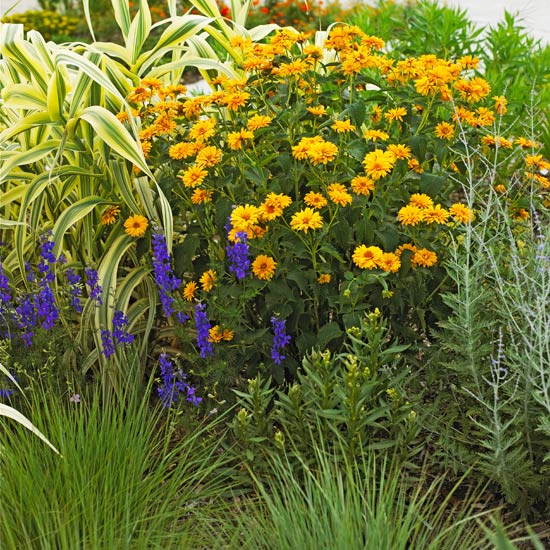
- Aubretia (Aubrieti deltoidea)
- Black-Eyed Susan (Rudbeckia hirta)
- Blanket Flower (Gaillardia x grandiflora)
- Butterfly Weed (Asclepias tuberosa)
- Cinquefoil (Potentilla)
- Daylilies (Hemerocallis)
- English daisy (Bellis perennis)
- Gayfeather (Liatris spicata)
- Giant allium (Allium giganteum)
- Lambs' Ear (Stachys byzantia)
- Lavender (Lavandula)
- Lilyturf (Liriope muscari)
- Oriental Poppy (Papaver)
- Peonies (Paeonia)
- Purple Coneflower (Echinacea purpurea)
- Salvia
- Sedum, taller types
- Snow-in-Summer (Cerastium tomentosum)
- Thyme (Thymus)
- Tickseed (Coreopsis)
- Wild Sweet William (Phlox divaricata)
- Wormwood (Artemisia)
- Yarrow (Achillea)
Annuals:
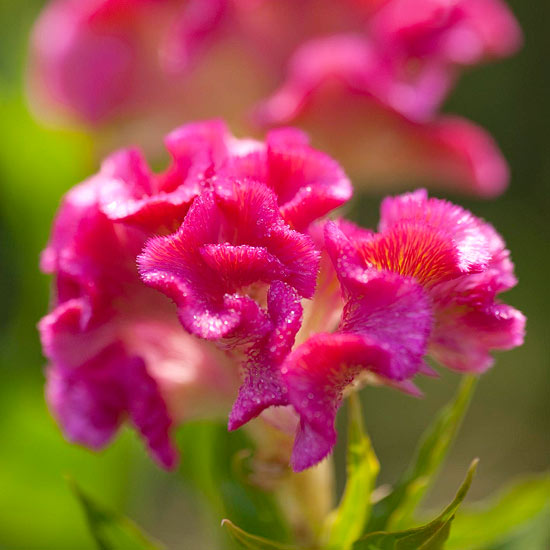
Celosia
- Annual Sunflower (Helianthus annuus)
- Celosia
- Cosmos
- Four O'Clocks (Mirabilis jalapa)
- Globe Amaranth (Gomphrena globosa)
- Moss Rose (Portulaca grandiflora)
- Sea Lavender or Statice (Limonium sinuatum)
- Summer Cypress (Kochia scoparia)
- Treasure Flower (Gazania rigens)
- Zinnia
Water-Wise Flowers for Arid Western States
Perennials:
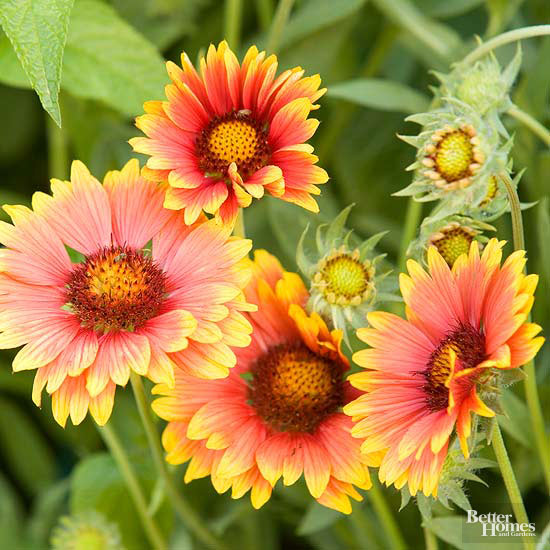
Blanket Flower
- African Iris (Dietes vegeta)
- African Lily (Agapanthus africanus)
- Blanket Flower (Gaillardia x grandiflora)
- California Blue-Eyed Grass (Sisyrinchium bellum)
- Candelabra Aloe (Aloe arborescens)
- Daffodil (Narcissus)
- Desert Marigold (Baileya multiradiata)
- Evening Primrose (Oenothera berlandieri)
- Flax (Linum flavum)
- Fleece Flower (Polygonum capitatum)
- Gayfeather (Liatris spicata)
- German Bearded Iris (Iris x germanica)
- Hoarhound (Marrubium vulgare)
- Ice Plant (Carpobrotus edulis)
- Jerusalem Sage (Phlomis fruticosa)
- Lavender (Lavandula)
- Monkey Flower (Mimulus lewisii)
- Naked Lady Lily (Amaryllis belladonna)
- New Zealand Flax (Phormium tenax)
- Penstemon
- Red Hot Poker (Kniphofia uvaria)
- Sea Lavender or Statice (Limonium)
- Verbena
- Yarrow (Achillea)
- Yucca (Yucca gloriosa)
Annuals:
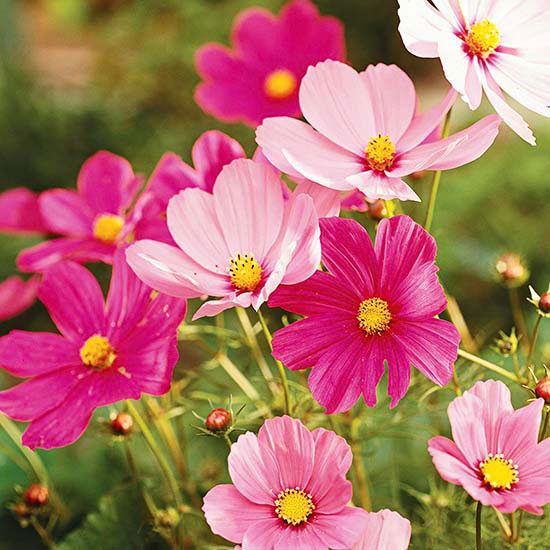
Cosmos
- Annual Sunflower (Helianthus annuus)
- Celosia
- California Poppy (Eschscholzia californica)
- Cosmos
- Four O'Clocks (Mirabilis jalapa)
- Globe Amaranth (Gomphrena globosa)
- Mexican Sunflower (Tithonia rotundifolia)
- Moss Rose (Portulaca grandiflora)
- Sea Lavender or Statice (Limonium sinuatum)
- Senecio
- Summer Cypress (Kochia scoparia)
- Treasure Flower (Gazania rigens)
- Zinnia
Water-Wise Flowers for the South
Perennials:
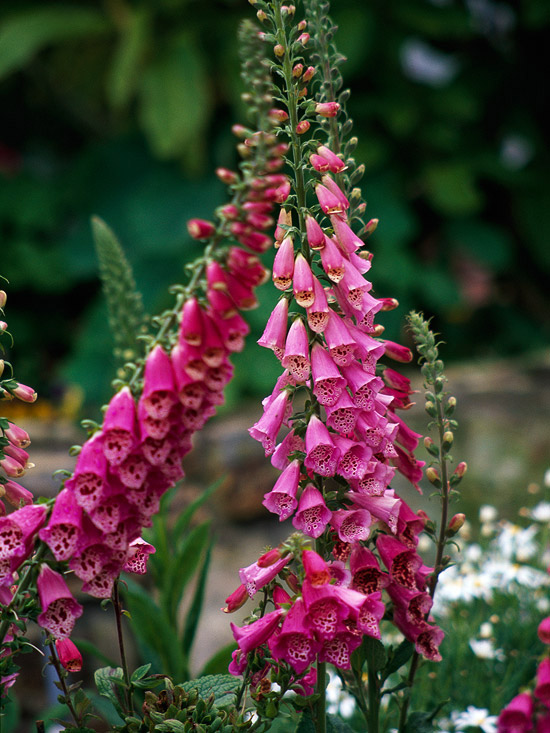
Foxglove
- Clump Verbena (Verbena canadensis)
- Foxglove (Digitalis purpurea)
- Gayfeather (Liatris scariosa)
- Goldenrod (Solidago altissima)
- Moss Verbena (Verbena tenuisecta)
- Purple Coneflower (Echinacea angustifolia)
Annuals:
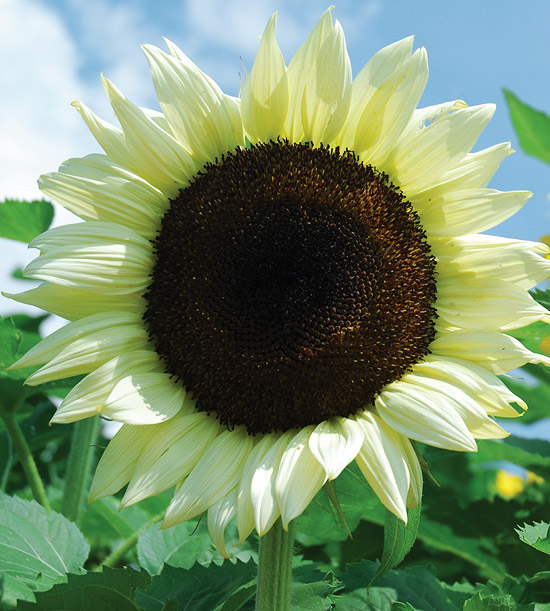
Annual Sunflower
- Annual Sunflower (Helianthus annuus)
- Blanket Flower (Gaillardia pulchella)
- Cosmos
- Mexican Tulip Poppy (Hunnemannia fumariifolia)
- Moss Rose (Portulaca grandiflora)
- Treasure Flower (Gazania rigens)











 Celosia
Celosia
 Blanket Flower
Blanket Flower
 Cosmos
Cosmos
 Foxglove
Foxglove
 Annual Sunflower
Annual Sunflower